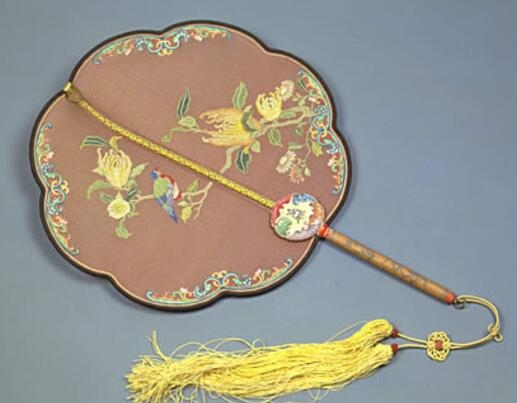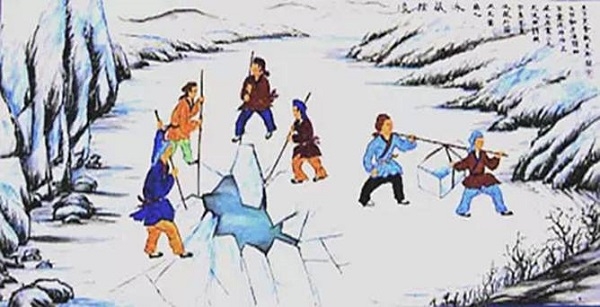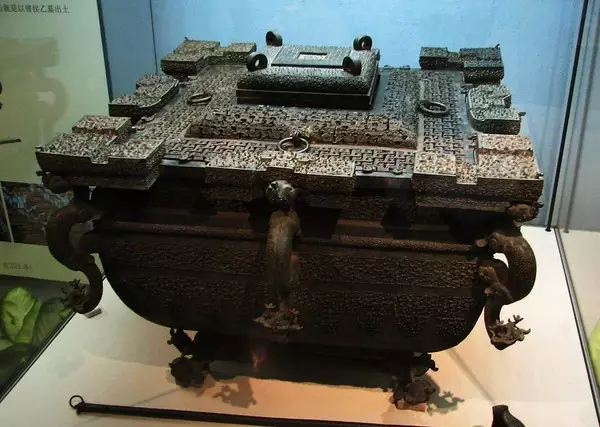Learn Ancient Chinese to Stay Cool in Summer
 |
| Learn Ancient Chinese to Stay Cool in Summer |
| Summary |
Today, people around the world continue to dress for the heat, wearing wide-brimmed hats and loose, light-colored clothing. Hand fans are still a necessary accessory in many of our neighboring islands. In the Mediterranean, people start their days before the sun gets too hot – and enjoy afternoon siestas to beat the heat. And they take their beds outside to sleep under
According to the Chinese solar terms, it's Minor Heat now, when most parts of China are going to experience the hottest days of the year. How did ancient Chinese people cool down without these modern-day technologies?
How did ancient people keep cool in the summer?
In ancient Egypt, for example, people hung damp reeds over windows and placed water-filled pots in hallways. As the water evaporated, it would cool the air. In the 1950s, Australian women living in the "back of Bourke" would soak bed sheets in water and hang them on the Hills Hoist to cool the air on the breeze. For a modern-day Canberra alternative, try sitting a bowl of water in front of a small fan.
In the Middle East, wind towers would direct air down into building interiors. Today, cross-ventilation can do the trick. Simply open windows and doors on opposite sides of the house to
The citizens of Rome circulated water through their homes using aqueducts, but a cheaper alternative is to soak your feet in a bucket of water or keep a spray bottle handy. Roman Emperor Elagabalus is said to have imported snow from the mountains on donkey trains. Today, it takes less effort to keep ice blocks in the freezer or take an ice pack to bed.
In Moorish Spain, trickling fountains and reflecting pools cooled the hot air, while deep-set windows and doors provided protection from the summer sun. So, close the blinds as soon as the sun comes up - and then open them when night falls to flush the house out with cooler night air.
Smart Ways to Keep Cool of Ancient Chinese
1. Fans
 |
| Photo: yumofchina |
At first, ancient Chinese people used leaves to cool themselves off—these are believed to be the original fans. Since leaves were easy to tear, fans weaved from bamboo strips subsequently came into being. Silk also can be used to make fans, but only rich people could afford them. The ancient Chinese literati enjoyed writing poems or putting paintings on the fans to express their elegant tastes. According to the records of the Han Dynasty (206BC-AD220), a wheeled device equipped with seven paddles was invented, which rolled rapidly to produce a cool breeze. However, this big machine was hard to afford for common people, so only the royal families were able to enjoy it.
2. Ancient Air Conditioning
In Tang Dynasty (618-907) there was a kind of “cool room”, similar to modern air-conditioned room. The “cool room” was generally built beside the streams, using cycling water to drive fan and to send cool air to the room, or using special mechanical device to draw water up to the roof, from where it would drop down and form a water spray that brought cool wind into the room. However, this method was hard to afford for common people, only the imperial families could enjoy it.
3. Cold Drinks
Fans and houses are the ways ancient people chose to make their bodies cool. But what about their mouths? Cold drinks were a good option.
About 3000 years ago, during the winter noble families would preserve ice in cellars, in preparation for the summer heat. Ice was very special in ancient times. In the Zhou Dynasty (About 1100-256BC), the royal court even had an official in charge of making cold drinks. In the late Spring and Autumn Period (770-476BC), the feudal princes loved to drink iced rice wine at banquets, for it tasted not only cool but also mellow.
Ice sellers emerged in the Tang Dynasty. They stored ice in winter and sold it in summer. In the later Tang Dynasty, the ice sellers added sugar to the ice to attract customers.
Cold drinks gained popularity in the Song Dynasty (960-1279). It even had stores that exclusively sold different kinds of iced drinks.
Iced sweet-sour plum juice, iced plum blossom wine, and iced bean soup were the most popular cold drinks at that time. Some celebrated painters of the Song Dynasty even painted scenes of cold drinks selling in their works.
4. Store Ice in Winter for Summer Use
 |
| Photo: China Whisper |
From the beginning of the Zhou Dynasty (1046-256 BC), the authorities already broke the ice in November and preserved ice in a cool place covered with straw and sawdust. Every few days in hot summer, the officials would dig ice out and divide into ministers.
In the Northern Song Dynasty (960–1127), common people also began to store ice in cellars. In the cold months of the year, people broke the ice and transported to the underground ice houses and sealed up. During the next summer, they would take the ice out piece by piece, make different kinds of iced drinks and sell them to customers.
5. Clothes
Although ancient Chinese fashion tended to be conservative, especially for women, the summer heat could drive anyone mad. To keep cool, women would wear thin, translucent clothes.
But translucent silk clothes were not just for women, men wore them as well.
For people living in the middle and lower reaches of the Huanghe River, clothing made of bamboo was popular. The material helped the wearer avoid perspiration.
6. Porcelain Pillows
Besides the methods mentioned above, ancient people also used porcelain pillows to relieve the summer heat.
China is noted for its porcelain, and the ancient Chinese not only used it to make bowls, plates and vases but also porcelain pillows. The surface of the porcelain pillow was glazed with enamel, making it smooth and cool. It is pleasant in hot summer to rest one’s head on the pillow to have a good sleep.
Porcelain pillows were originally made in the Sui Dynasty (581-618) and were put into mass production after the Tang Dynasty (618-907), and they got popular during the Song Dynasty (960-1279) to Yuan Dynasty (1271-1368). Porcelain pillows were made in various shapes, delicate in quality and skillful in technique, among which the porcelain pillows of the Song Dynasty were most well-known for their artistic value. Cizhou kiln, Dangyangyu kiln and Dengfeng kiln were the three kilns that produced the most porcelain pillows in the Song Dynasty.
The baby-shaped pillow from the Ding kiln of the Song Dynasty not only reflected the superb skills of craftsmen but also signified that the society of the Song Dynasty paid great attention to children. People of that time thought kids symbolized auspiciousness and could bring happiness to families and avoid evil things.
After the Ming and Qing Dynasties (1368-1911), with the appearance of more suitable materials for making pillows, porcelain pillows gradually faded away from people’s daily life.
7. Ancient Refrigerator
 |
| Photo: chinlingo |
Ancient Chinese already invented a mini ice house to keep wine cool in hot summer, this can be regarded as the earliest refrigerator in China. The above instrument is called Jian, a bronze container from the Warring States Period (475-221BC). It has two layers and the inter-layer will be stuffed with ice to keep the wine cool.
In the late Qing Dynasty (1644 – 1912), the common people used ice buckets, which had a similar function similar with modern refrigerators. They use wood to make the framework and low heat conductivity metals of lead and tin to extend the time of ice use.
 What is the World's First Refrigerator Ever Made - History in Timeline What is the World's First Refrigerator Ever Made - History in Timeline The refrigerator has become one of the essential appliances in daily affairs. Have you ever wondered about the history of the fridge? What is ... |
8. Hiding Food in the Well
During the Qin (221-207 BC) and Han (202 BC-AD 220) dynasties, for common people, the most common way to cool off is by using their wells. Some families put an urn in the well as a cold closet, or put food in a basket and lowered the basket into the well with a rope.
Actually, ancient people don't need cold beverages, as well water was the best drink in summer.
9. Dragon Fur Curtain
The dragon fur curtain was used during ancient times to block the hot waves in the summer, and keep interiors pleasantly cool. It was not really made of dragon fur, since there are no such creatures as dragons, so some say it was made of the skin of large boas.
Surrounded by large and cold boa skins, the place would feel like an air-conditioned room. However, the skin was precious and difficult to obtain, so only the royal court was able to use it.
10. Bamboo Lady
Ancient people in the southern parts of China preferred to use cylinder-shaped bamboo ware, which is hollow in the middle and has grid mesh on the surface. It uses the principle of cross ventilation to cool people down and can be hugged, or used to hold up your feet.
How did ancient people stay warm in winter?China is where coal was first discovered and used to cook and keep warm. Tang Dynasty (AD 618-907) imperial families were recorded to have used imported coal. Most families used manmade charcoal while wealthy families had more requirements on coal. The residence of Yang Guozhong, who was the prime minister of Tang Dynasty Emperor Xuanzong, used special coal in winter. The carbon dust was kneaded into a double-phoenix shape using honey, and fine sandalwood was paved at the bottom of the stove while burning, which was very clean. Censer was often used for heat during ancient times, which was made of two parts: the bottom was a basin and the top was a hollow cover made with flower patterns. Putting coal inside, censers were used as warmers and made into different sizes for hands and feet. The censers were usually copper-made in the royal court and clay or iron-made among folk people. Tangpozi, a pumpkin-shaped bronze kettle full of boiling water was also quite commonly used to keep warm in ancient times. It could be put under a quilt, similar to today's hot-water bottle. All these warmers require fuel, and fuel occupied a large part of expenses in winter, so the court gave coal subsidies to officials. During the Song Dynasty (960-1279), the subsidy was paid by giving out coal, and the Ming Dynasty gave out cash instead. Ancient royal court had a special team, called "coal soldiers", to solve the heating supply issue, taking charge of the official use of coal. |
 Top 15+ Most Popular Student Tools to Help Improve Learning Top 15+ Most Popular Student Tools to Help Improve Learning There are a lot of popular tools that students use to make their education more manageable. This post will discuss the best tools that can ... |
 Top 10+ Best Free Websites to Learn NFT Online and Earn Money Right Now Top 10+ Best Free Websites to Learn NFT Online and Earn Money Right Now Learn NFT with the best 10 free NFT tutorials and online courses free in this post right now! |
 Top 10 Best Programming Languages to Learn Right Now Top 10 Best Programming Languages to Learn Right Now Which programming languages will continue to be in demand in 2022 and beyond? How many languages should you learn? Find the answer to these tricky ... |























